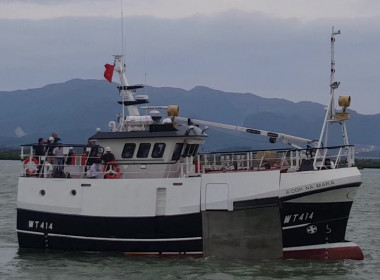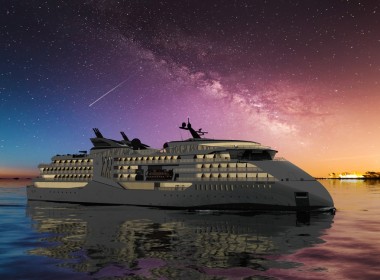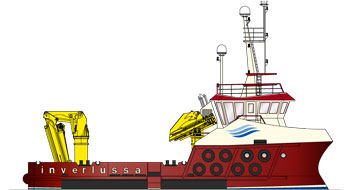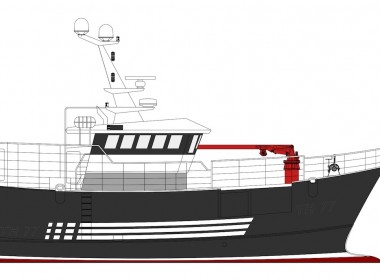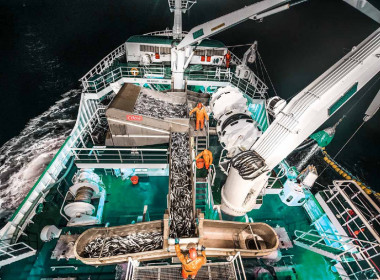AWARDS 2020 | Best Offshore Fish Farm – Havfarm 1 – NSK Ship Design

Best Offshore Fish Farm – Havfarm 1 – NSK Ship Design
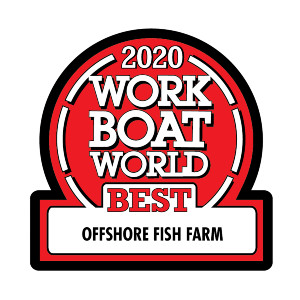
Long time readers of these pages will recall that Baird Maritime has for many years (at least 23 years!) been promoting the development of larger, more seaworthy, offshore fish farms. This was with the objective of reducing sea lice attacks, and excreta and food pollution problems.
Siting farms in deeper water further away from civilisation will have several aesthetic, environmental, fish health and economic benefits, but they have to be paid for with larger, stronger farm structures and service vessels. That is why it is so exciting to see those concepts put into practice with the construction in China and delivery to Norway of this magnificent semi-submersible “vessel”.
It was great to see that Norwegian designer NSK Ship Design has created this very large (at 385 metres LOA) and very substantial fish farm that has been built to survive and continue to operate in very big seas. It is a brave but very logical move. We, and many of our readers, will be very interested in its progress.
“Havfarm 1 is unique in many aspects,” NSK told Baird Maritime. “Most importantly, it enables large-scale fish farming in harsh environments, something that has not been done before. This gives the fish farmers the optimal tool to operate safely in rougher waters and to increase their available areas and number of fish farming locations. This technology in turn allows national production capacity to increase manyfold, but in a sustainable way.”
NSK added that fish health was another key consideration that went into the farm’s design. Specifically, Havfarm 1‘s design means service calls for maintenance will no longer need to be carried out daily. Even resupply using other vessels that carry feed and live fish may be done less frequently compared to before. In other words, fewer vessels traveling back and forth between the farm translates into a significantly reduced risk of the spread of disease.
Operating in exposed waters will even make it possible for multiple fish farms to be safely installed in a single area with greater distances between them. This will also lead to less risk of the spread of disease and sea lice.
“Havfarm 1 has repeatedly proven its capabilities, even as the area it is operating in experienced winter storms. This has given a lot of confidence to the owner for further developments and operation in harsh environments.”
NSK said the development of the innovative facility was in response to an increasing preference for low-emission vessels, including those used in the aquaculture industry.
“We’ve been seeing a growing national and international focus on lowering emissions and a lot of development goes into zero-emission vessels for all uses,” the company told Baird Maritime. “In addition, we’ve been seeing regulations becoming somewhat relaxed for those wishing to venture into offshore fish farming, and this has opened up opportunities for a lot of fish farm operators and even design companies.”
The company nonetheless clarified that aspiring operators must focus on getting the necessary authority approvals for using proven technology instead of newer, higher-risk alternatives when it comes to putting up and operating fish farms in deeper waters.
“Both categories will in the long run contribute to the growth of overall salmon production,” remarked NSK, “but the largest growth in the short to medium term will be from exposed fish farming, which already utilises proven and readily available technology.”
The completion of Havfarm 1 was just one of the projects that made 2020 “a good year both technically and financially” for NSK. Other noteworthy designs developed by the company in the previous year include a DP-capable fish farm and a salmon farm for more benign waters. The latter comes with double barriers to prevent salmon from escaping as well as a sludge collection system capable of collecting more than 90 per cent of faeces and fish feed spill to further reduce carbon footprint.
“We have grown from a small consultancy to becoming one of the major design houses for aquaculture mega projects,” commented NSK, “so it is safe to say that during the last five years, no year was like the previous one. Also, with our current portfolio and with other offshore fish farm projects under development, we can safely say that we are optimistic for the future.”
NSK claims sustainability will be an even greater driving force in the aquaculture industry in the future. The company believes innovations such as collection systems for faeces and feed spill, shore charging capability for vessels, systems for reducing life infestation, and exposed and offshore fish farms will therefore be in great demand.
“Future fish production will also be mixed,” NSK told Baird Maritime. “Production will most likely consist of a variety of the available production methods with part of the production cycle on shore, part in benign waters and parts exposed or offshore. This will not only reduce carbon footprint and lice exposure, but also increase production.”
The company added that, since the aquaculture industry has a complex supply chain, it will require robust infrastructure that can also incorporate innovations and other technology. This will apply not only to the vessels themselves but also to their onboard systems such as those used for fish treatment and sludge handling.
When asked about the future of the commercial marine industry in Norway, NSK commented that the industry is headed in the same direction as that of the aquaculture industry.
“The commercial marine industry’s focus for the coming years will be on the development of sustainable vessels and zero-emission technology,” said NSK. “We will therefore see growing numbers of vessels being powered by ammonia, hydrogen, methanol, batteries, and other low-emission fuels.”
NSK said there will also be a growing focus on autonomous vessels. However, the company believes the long-term goal of using such technology should be to improve safety and efficiency in operations rather than to simply replace human crews on board vessels.




